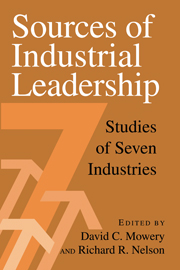Book contents
- Frontmatter
- Contents
- Acknowledgments
- List of Contributors
- 1 Introduction
- 2 The Evolution of Competitive Advantage in the Worldwide Semiconductor Industry, 1947–1996
- 3 Industrial Dynamics and the Evolution of Firms' and Nations' Competitive Capabilities in the World Computer Industry
- 4 The Computer Software Industry
- 5 Innovation in the Machine Tool Industry: A Historical Perspective on the Dynamics of Comparative Advantage
- 6 Dynamics of Comparative Advantage in the Chemical Industry
- 7 The Pharmaceutical Industry and the Revolution in Molecular Biology: Interactions Among Scientific, Institutional, and Organizational Change
- 8 Diagnostic Devices: An Analysis of Comparative Advantages
- 9 Explaining Industrial Leadership
- Index
3 - Industrial Dynamics and the Evolution of Firms' and Nations' Competitive Capabilities in the World Computer Industry
Published online by Cambridge University Press: 05 June 2012
- Frontmatter
- Contents
- Acknowledgments
- List of Contributors
- 1 Introduction
- 2 The Evolution of Competitive Advantage in the Worldwide Semiconductor Industry, 1947–1996
- 3 Industrial Dynamics and the Evolution of Firms' and Nations' Competitive Capabilities in the World Computer Industry
- 4 The Computer Software Industry
- 5 Innovation in the Machine Tool Industry: A Historical Perspective on the Dynamics of Comparative Advantage
- 6 Dynamics of Comparative Advantage in the Chemical Industry
- 7 The Pharmaceutical Industry and the Revolution in Molecular Biology: Interactions Among Scientific, Institutional, and Organizational Change
- 8 Diagnostic Devices: An Analysis of Comparative Advantages
- 9 Explaining Industrial Leadership
- Index
Summary
The Major Issues
The evolution of the computer industry over the long term illustrates many of the broad themes addressed by this book. In particular, it highlights the coevolution of technology, market structure, and institutions and addresses the sources of international competitive advantage. Since its inception in the early 1950s, the computer industry has been characterized by rapid and sustained technical change, continuous product innovation punctuated by a few major breakthroughs, creation of new uses for computers and new markets, and coexistence between established actors and new entrepreneurial firms. And since the beginning of the industry, one country – the United States – has been the world technological and competitive leader.
From these observations drawn from the history of the world computer industry, some questions emerge. A first set of questions refer to the relationship between radical change and competition among incumbents and new firms. How is it that old and new firms coexisted during the history of the computer industry? Is there a link between radical innovations' opening up new markets and the competition between old and new actors? A second set of questions relate to the specific relationship among technological change, market structure, and institutions during the history of the industry.
- Type
- Chapter
- Information
- Sources of Industrial LeadershipStudies of Seven Industries, pp. 79 - 132Publisher: Cambridge University PressPrint publication year: 1999
- 41
- Cited by



